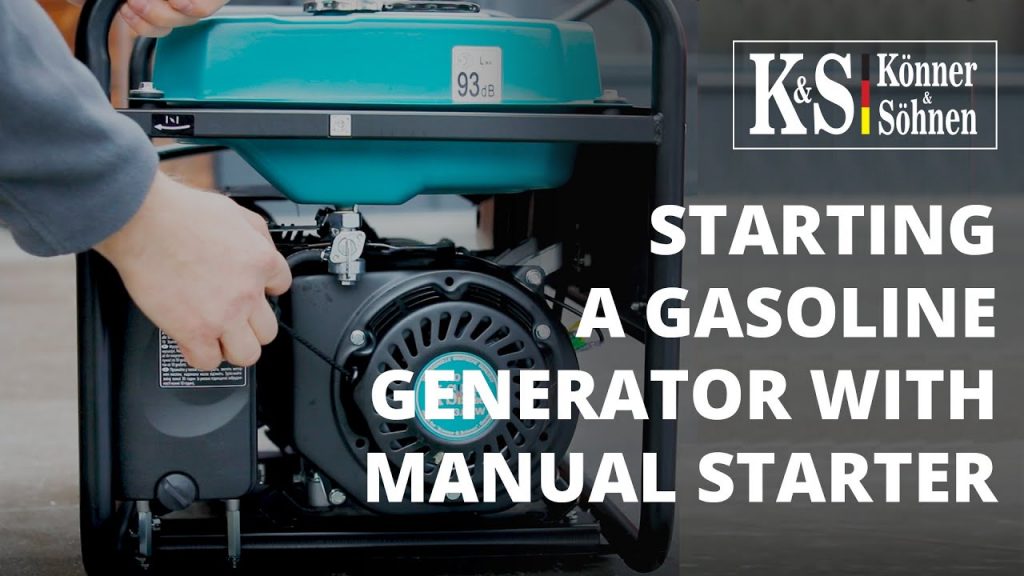Starting a gas generator is easy and can be done in a few simple steps. First, you need to make sure that the generator is properly connected to your home. To do this, you will need to connect the generator to your house’s electrical panel. This will involve connecting a transfer switch that is connected to both the generator and the electrical panel. Next, you will need to prepare the generator for use.
This includes turning on the fuel valve and making sure that the generator’s oil level is at the correct level. Once the generator is ready, you will need to turn the generator switch on. This will ensure that the electricity is flowing from the generator to the electrical panel. Finally, you will need to use a surge protector to protect the generator from power surges. This will help prevent any electrical damage from occurring. Once all of these steps have been completed, your generator should be ready to use. Ensure that you are following all safety precautions while using your generator and that it is used responsibly.
How to turn on the generator?
Starting a gas generator is a relatively easy task, but there are important steps to take for safety reasons.
- First, make sure there is an adequate supply of fuel, such as gasoline, available for the generator.
- Then, ensure that the generator is placed on a flat surface in a well-ventilated area.
- Next, press the fuel valve, usually located on the side of the generator, to open the fuel line.
- Then, locate the start switch, usually near the control panel, and press it to turn on the generator.
- Before connecting any appliances to the generator, it is important to allow the unit to warm up for several minutes.
- Finally, to ensure the generator is operating correctly, review the engine RPM gauge and make sure it is within the manufacturer’s specified range.
How do you Power Your House with a generator?
First, you will need to check the oil level and make sure there is enough fuel in the tank. If the fuel level is too low, you will need to add more fuel before starting the generator. Next, make sure the generator is located in an area with proper ventilation. You should also ensure that the exhaust pipe is clear of any obstructions. Now, you can turn on the switch and pull the starter cord to start the engine.
Once the engine is running, you will need to adjust the speed of the generator according to the amount of power you need. To ensure the generator is working properly, it is important to regularly check the oil and fuel levels, as well as any signs of wear and tear. You should also keep an eye on the exhaust pipe and make sure it is free of blockages. Finally, you can now plug in any appliances that need to be powered and turn them on. With a well-functioning generator, your house should now be powered up and ready to use.
Why wont my portable generator start?
Starting a gas generator can be a difficult task if you’re inexperienced. If you experience difficulty starting your portable generator, it is important to first identify the issue. Common reasons why your gas generator won’t start include: faulty spark plug, bad fuel, clogged air filter, insufficient fuel supply or a dead battery. If you’re having difficulty starting your generator, the first thing you should do is check the spark plug. If it is corroded or damaged, it needs to be replaced.
If the spark plug appears to be in good condition, you should inspect the fuel tank for any clogs or debris. If there is debris, you should clean the fuel tank and replace the fuel filter. Next, if your fuel tank is clear, ensure that you have enough fuel in the tank to start the generator. If the fuel supply is low, add fuel to the tank and try starting the generator again. Finally, check the battery to make sure it is charged and in good condition. If the battery is dead, you will need to replace it before the generator can start. By following these steps, you can usually identify why your portable generator won’t start and take the necessary steps to get it running.
How do I start my generator?
Knowing how to start your generator can be the difference between being prepared for a power outage or feeling helpless. The first step to starting a gas generator is to make sure the fuel tank is full and that the fuel valve is open. You should also check the oil level and the spark plug to make sure they are in good condition. Next, you will need to prime the fuel system by placing a few drops of fuel directly into the carburetor. This will help the generator start up more easily.
Once everything is ready, locate the starter cord and pull it several times until the engine starts. If the engine still doesn’t start, you will need to check the spark plug and carburetor to make sure they are both working properly. Once the generator is running, you can turn on the circuit breakers to start powering your appliances. Following these steps will ensure that you can confidently start your gas generator whenever needed.
How to start a portable generator without electricity?
Starting a gas generator without electricity is not difficult, but there are a few things to consider. Firstly, make sure you have the right type of fuel and oil for your particular generator. You should also check that the spark plugs are in good condition. Once you have these elements in place, you can begin the process of starting the generator. Firstly, make sure the fuel valve is in the ‘on’ position.
Then, if your generator has a primer bulb, press it a few times to get the fuel mixed with the air. Next, turn the choke lever to the ‘open’ position and pull the starter cord several times. At this point, the generator should start running. If not, check the fuel and spark plug connections, as well as the air filter. When the generator is running, it’s important to adjust the choke lever to the ‘half open’ position. This will ensure the generator runs smoothly and efficiently. Finally, if your generator has an electrical switch, you can turn it on to power any electrical items you need. If you follow these steps, you should be able to start your gas generator without electricity.
How do you fix a generator that won t start?
If your gas generator won’t start, the first step is to check the fuel. Make sure that there is adequate fuel in the tank and that it is in good condition. If there is a problem with the fuel, replace it and try starting the generator again. Next, check the oil level. Make sure that the oil level is at the correct level as instructed in the user manual.
If the oil level is too low, add oil and try starting the generator again. If the fuel and oil levels are okay, the next step is to check the spark plug. Make sure that it is in good condition and properly connected. If the spark plug needs to be replaced, replace it and try starting the generator again. The last step is to check the generator’s battery. Make sure it is fully charged and in good condition. If it needs to be replaced or recharged, replace or recharge it and then try starting the generator again. If all of the above steps have been completed and the generator still won’t start, it may need to be serviced by a professional. A qualified technician can diagnose and repair any issues with the generator.
What products do you need to start a generator?
Starting a gas generator can be a daunting task for anyone unfamiliar with the process. To begin, there are certain products that need to be obtained before attempting to start the generator. The first item is the fuel, which is typically gasoline or propane. Depending on the type of generator, the fuel must be purchased in a specific form. For example, many generators require a high octane fuel.
Next, an electric starter will be needed to ignite the generator. This is usually a small battery connected to a starter switch. The battery must be compatible with the generator in order to work properly. In addition, an oil filter will be necessary to ensure the generator continues to run properly. This should be replaced at regular intervals according to the manufacturer’s instructions. Finally, a spark plug will be required to complete the generator’s ignition process. This must be checked for corrosion and wear before each use. By obtaining the correct products and following the manufacturer’s instructions, anyone can start a gas generator with relative ease.
How do we start a gas turbine?
First, check that all the safety features are in place and that all fuel supplies are connected. Next, check the turbine’s oil pressure and temperature. Once these have been verified, the turbine can be started. To start the turbine, a control system will need to be put into operation. This will direct the turbine to the desired speed and power output.
Depending on the model of turbine, a variety of techniques will be employed to start the turbine. This includes the use of high-pressure air or steam, high-pressure gas, or an electric motor to spin the turbine up. Once the turbine has reached the desired speed and power output, it must be slowly brought up to the full design speed. This is done by increasing the turbine’s energy input, usually through fuel or air. During this process, the turbine must be monitored and checked to ensure that the correct operating temperature and pressure are maintained. Once the turbine reaches full speed and power, the fuel supply must be adjusted to maintain the desired level of power output. This includes monitoring fuel pressure, temperature, speed, and other parameters. Finally, the turbine needs to be checked for vibration and noise levels, as well as any potential safety issues. By following these steps, one can safely and efficiently start a gas turbine. It is important to be aware of all safety considerations, to properly check the turbine before use, and to properly monitor it while it is running. Following these steps will ensure that the turbine runs smoothly and efficiently.
How to start a portable generator safely?
First, make sure that the generator is connected to a properly grounded outlet and that the fuel tank is full. In the case of a portable generator, be sure to place it on a flat and even surface. Next, check the oil level and make sure it is at the proper level. This is important to ensure the engine runs smoothly. Next, move the fuel shut-off valve to the “on” position, press the “prime” button to prime the fuel lines, and then press and hold the “start” button.
If the generator doesn’t start, make sure that it is receiving fuel and the fuel shut-off valve is in the “on” position. Finally, allow the generator to run for a few minutes to warm up before it is used. If the generator is going to be used for long periods of time, be sure to turn the fuel shut-off valve to the “off” position after each use. This practice helps to ensure the safety of the generator and its components.






